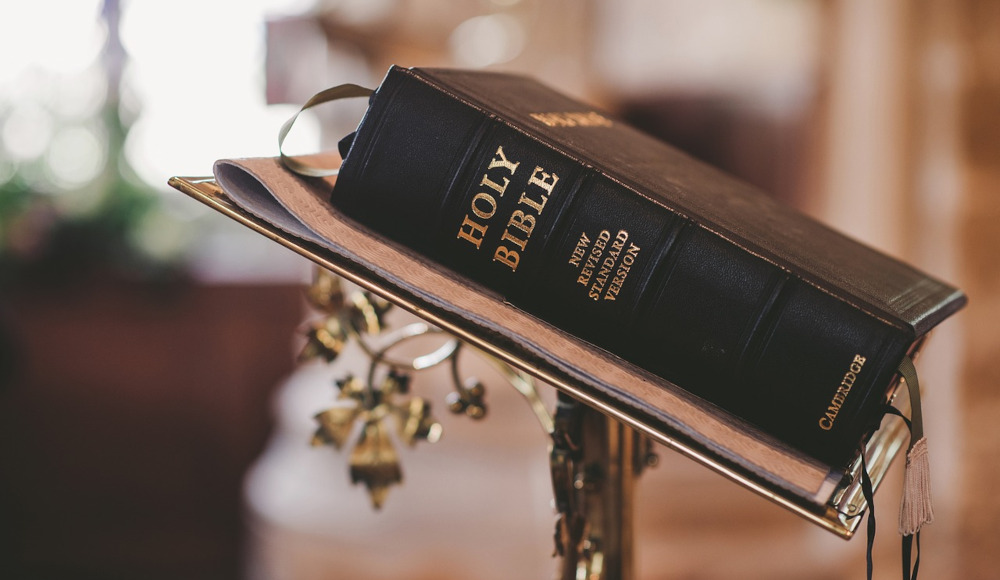In a dimly lit room filled with scrolls and quills, an old monk sat hunched over a table.
His wrinkled hands carefully guided a feathered pen across an unfurled parchment, marking the pages with elegant strokes.
As his work came to a close, he leaned back and smiled faintly at the piles of manuscripts stacked around him.
Centuries of work had preceded this moment. Since its earliest days, the Bible’s words had been passed down by faithful scribes like himself.
Though it began as scattered stories and letters, the monk had helped compile them into the sacred book that now sat before him.
Gently blowing on the ink to dry it, he reflected on the long and arduous journey that had brought these holy texts together. He thought back to the authors who first put quill to parchment to share the wisdom that inspired them.
He remembered the discussions and debates over which writings were divine and should be included. So much passion and scholarship had gone into creating this Book of books.
Now, as copying gave way to printing, the monk knew the Bible’s pages would spread far beyond the monastery walls.
The tales within would be told and retold, translated into every tongue, its message of hope and grace passed on for generations to come.
Though his body would soon fail him, the monk rejoiced in what his life’s work had wrought.
What was once lovingly written by human hands, the Bible would now touch countless human hearts for years to come.
A Collection of Sacred Texts Written by Many Authors

The Bible is not a single work by one author, but rather a collection of ancient texts written and compiled over many centuries by different writers in different contexts.
The Hebrew Bible contains 39 books written primarily in Hebrew, reflecting the history and culture of the ancient Israelites. These texts were written from approximately the 12th to the 2nd century BC.
The Christian Bible includes those 39 books, called the Old Testament, along with 27 additional books, called the New Testament.
These were written in the common (Koine) Greek language used around the Mediterranean between 50 and 120 AD.
Though there is debate about authorship, these New Testament books had multiple authors including the Apostles Matthew, John, Paul, and others.
In total, the Bible contains 66 separate books or texts written over 1500 years! It reflects not only Hebrew culture and history but also that of the early Christian church.
The Development of the Old Testament

The 39 books of the Hebrew Bible are considered sacred texts in Judaism.
For Christianity, these books are called the “Old Testament” and serve as a backstory for the New Testament.
The Old Testament can be divided into three parts:
- The Torah or Pentateuch, meaning “five scrolls”, contains the books of Genesis, Exodus, Leviticus, Numbers, and Deuteronomy. These books tell foundational stories like Adam and Eve, Moses, and the Ten Commandments.
- The Prophets include major and minor prophetic works. Major prophets like Isaiah and Jeremiah have whole books named for them, while minor prophets share one book.
- The Writings include history, poetry, songs, and wisdom literature. Well-known books in this section include Psalms, Proverbs, and Job.
According to tradition, the first five books of the Old Testament or Torah were written by Moses, though some Bible scholars believe they had many authors and underwent editing over time.
The books were originally written on scrolls and some passages may have first been handed down as oral traditions.
Other Old Testament books are attributed to prophets like Isaiah and Jeremiah, priests like Ezekiel, and Israelite leaders like Joshua and Ezra. But in many cases authorship is uncertain.
The Old Testament was written primarily in Biblical Hebrew. By 400 BC the 39 texts recognized today had been completed and compiled as the Hebrew Bible.
However, small changes continued to be made to the texts after that.
When Was the New Testament Written?

While the Old Testament developed over centuries, the 27 books of the Christian New Testament were written within a single century, spanning from approximately 50 to 120 AD.
The first New Testament texts were Paul’s letters written to the early Christian church.
Paul was a major figure in spreading Christianity outside of Judea. His letters encouraged the new faith communities and helped establish Christian theology.
The four gospels – Matthew, Mark, Luke, and John – came next, providing accounts of Jesus’s life and teaching. The Book of Acts narrates the early days of the church.
Letters from apostles like Peter and John offer practical advice for the growing religion. Finally, Revelation provides an apocalyptic vision of the end times.
The authors of the New Testament were followers of Jesus who wrote in Greek rather than the Hebrew of the Old Testament.
The New Testament provides a firsthand look at the beginnings of Christianity and its separation from Judaism.
From Original Languages Hebrew and Greek Manuscripts to the First Printed Bibles

The books of both the Old and New Testaments were copied by hand on scrolls and codices (early bound books) as they circulated in their original Hebrew and Greek languages.
As Christianity spread, the Bible began to be translated into other languages like Latin and Syriac.
In 382 AD, the Pope commissioned Jerome, a priest, and scholar, to translate the entire Bible into Latin. This became known as the Vulgate and for over a thousand years was the definitive version of the Bible for Western Christianity.
The Hebrew texts continued to be preserved by Jewish scribes. One of the oldest surviving Hebrew texts of the Old Testament is the Aleppo Codex from the 10th century AD.
With the invention of the printing press around 1440 CE, the Bible became more widely available. Johann Gutenberg printed the first complete Bible in Latin in 1455.
Within just 50 years, over 150 editions of the Bible were printed in a variety of languages, feeding growing interest in the Scriptures during the Protestant Reformation.
History of The English Bible
The first complete English Bible was printed in 1535 by Miles Coverdale. However, the most influential English translation would come in 1611 with the King James Bible.
For centuries the King James Version became the dominant Bible for English readers worldwide.
Modern Translations Make the Bible Accessible

In more recent centuries, discoveries of ancient biblical manuscripts led to new scholarly translations into English.
With the 1947 discovery of the Dead Sea scrolls, the oldest Hebrew manuscripts of the Old Testament were 1000 years older than previously available texts.
This improved scholarship around the original meanings of the Hebrew sacred texts.
Similarly, a study of Greek papyrus fragments from Egypt clarified meanings in the New Testament.
Modern English translations like the New International Version (1978) were translated directly from the most ancient Greek and Hebrew texts rather than indirect translations through Latin.
Today there are English translations of the Bible catering to every preference from formal word-for-word translations to informal paraphrased formats.

Technology now even makes the Bible accessible through smartphones, websites, and audio versions.
While Bible readership has declined somewhat in the United States, globally the Bible remains the best-selling book every year.
As one of the world’s foundational texts, the Bible has irrevocably shaped language, art, culture, and faith.
Understanding its origins and history provides insight into much of Western civilization.
Key Takeaways
- The Bible is made up of 66 separate books written over the course of 1,500 years in Hebrew, Aramaic, and Greek.
- The Old Testament contains 39 books of the Hebrew Bible, documenting Israelite history and culture from approximately the 12th to the 2nd century BC.
- The New Testament contains 27 books written between approximately 50 and 120 AD in common Greek, documenting the life of Jesus and the beginnings of Christianity.
- The Bible was originally written on scrolls and codices, then translated into Latin and other languages, before the printing press allowed wide publication in the 15th century.
- Modern translation from ancient source texts has made the Bible widely accessible, though readership has declined in the West even as it remains the world’s perennial bestselling book.
Frequently Asked Questions
Q. When was the first complete Bible published?
A. The first complete Bible printed with movable type was the Gutenberg Bible in Latin, published in 1455 in Mainz, Germany. The first complete English Bible was printed in 1535 by Miles Coverdale.
Q. What was the first book of the Bible written?
A. Some scholars believe the first book written down was the Book of Exodus, which may have been composed in the 6th century BC as part of the Torah or Pentateuch, the first five books of the Bible.
However, much of Genesis may have existed in oral tradition before being codified.
Q. Who actually wrote down the stories of the Bible?
A. The Bible’s books had many authors. Old Testament books are attributed to prophets, priests, and Israelite leaders.
New Testament books were likely written by Jewish followers of Jesus, including the Apostles Matthew, John, and Paul. However, authorship is uncertain for some books.
Q. When did the Old Testament start?
A. The 39 books of the Hebrew Bible that make up the Christian Old Testament were written between approximately the 12th and 2nd centuries BC. However, some oral traditions may be far older.
Q. What language was the Bible first written in?
A. The Old Testament was written primarily in ancient Hebrew, along with some Aramaic. The New Testament was written in Koine Greek.
Q. How was the Bible transmitted before printing?
A. Texts were painstakingly copied by hand onto scrolls and codices. They were circulated and translated into languages like Greek, Latin, and Syriac. Scribes carefully preserved the Hebrew manuscripts.
Q. What is a testament book?
A. A testament book refers to one of the books in the Bible that is part of either the Old Testament or the New Testament. These books contain religious texts and teachings.
Q. What are the books of the New Testament?
A. The books of the New Testament are the twenty-seven books that make up the second part of the Christian Bible. These books include the Gospels, Acts of the Apostles, Epistles, and the Book of Revelation.
Q. How is the Bible translated into English?
A. The Bible in English has been translated into various versions over the centuries. The translation process involves linguistic expertise, biblical scholarship, and adherence to the original texts.
Q. What are Bible translations?
A. Bible translations are versions of the Bible that have been translated from the original Hebrew, Aramaic, and Greek languages into different languages, including English. These translations aim to make the Bible accessible to a wider audience.
A. Is the Bible a collection of texts?
A. Yes, the Bible is a collection of religious texts that were written over a span of centuries by different authors. It contains various genres such as historical accounts, poetry, prophecy, and teachings.
Q. How did the Bible as we know it come to be?
A. The Bible as we know it is the result of a long process of compilation and canonization. The early church played a significant role in selecting and recognizing the inspired texts to be included in the Bible.
Q. What is the significance of the Hebrew language in the Bible?
A. The Hebrew language was used to write several books of the Old Testament, including the Torah (the first five books).
Understanding the Hebrew language helps in interpreting the original meaning of the biblical texts.
Q. How are translations of the Old Testament done?
A. Translations of the Old Testament involve studying the original Hebrew texts and employing linguistic expertise to convey the intended meaning accurately in different languages, including English.






